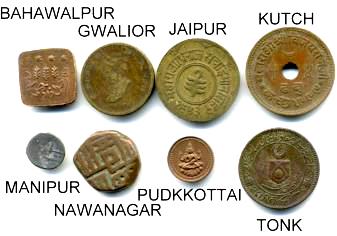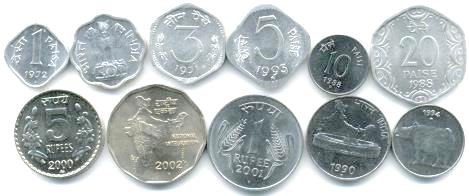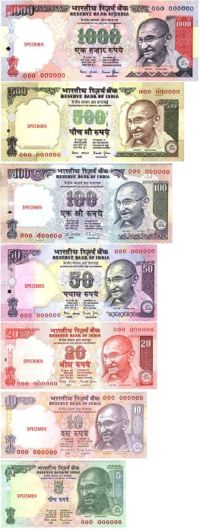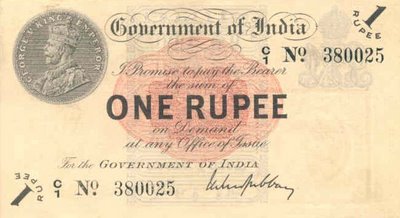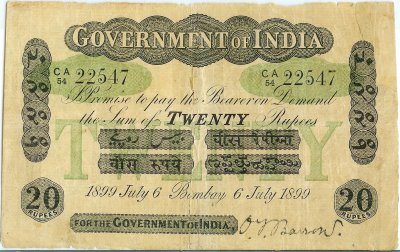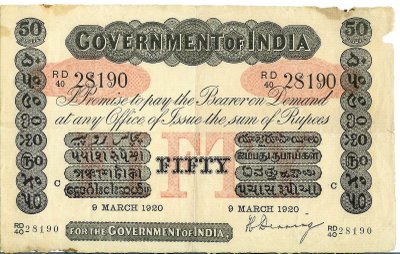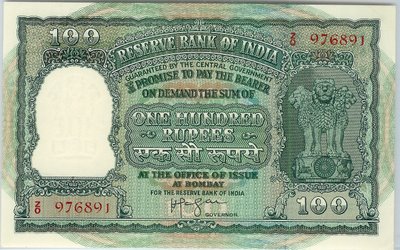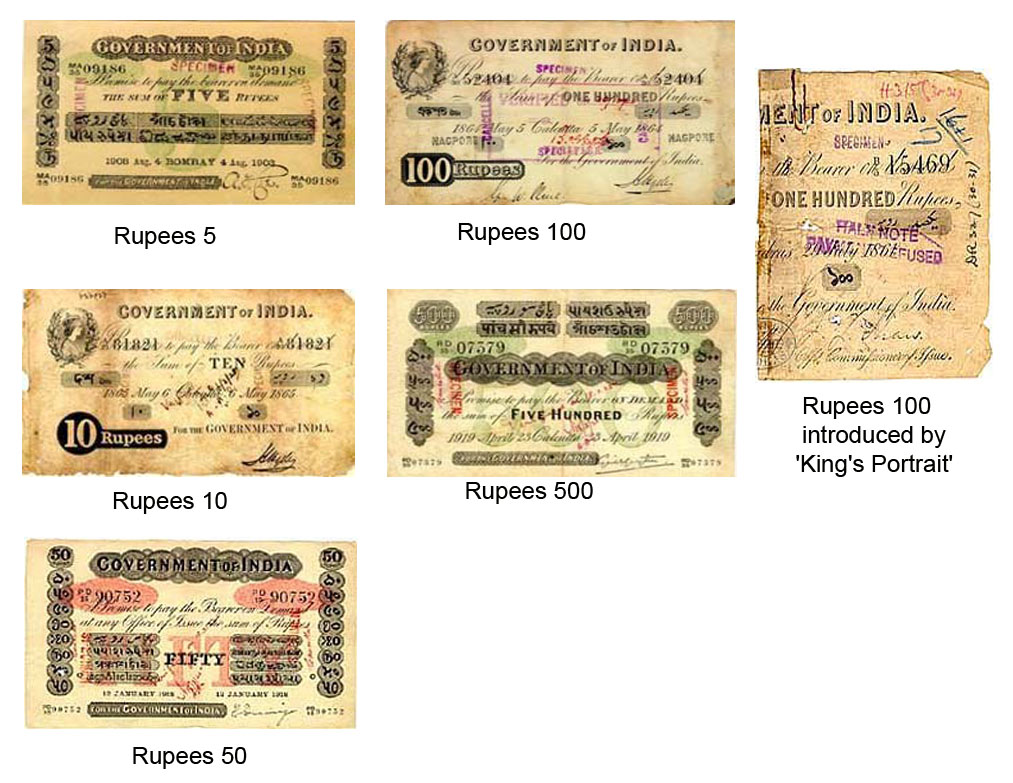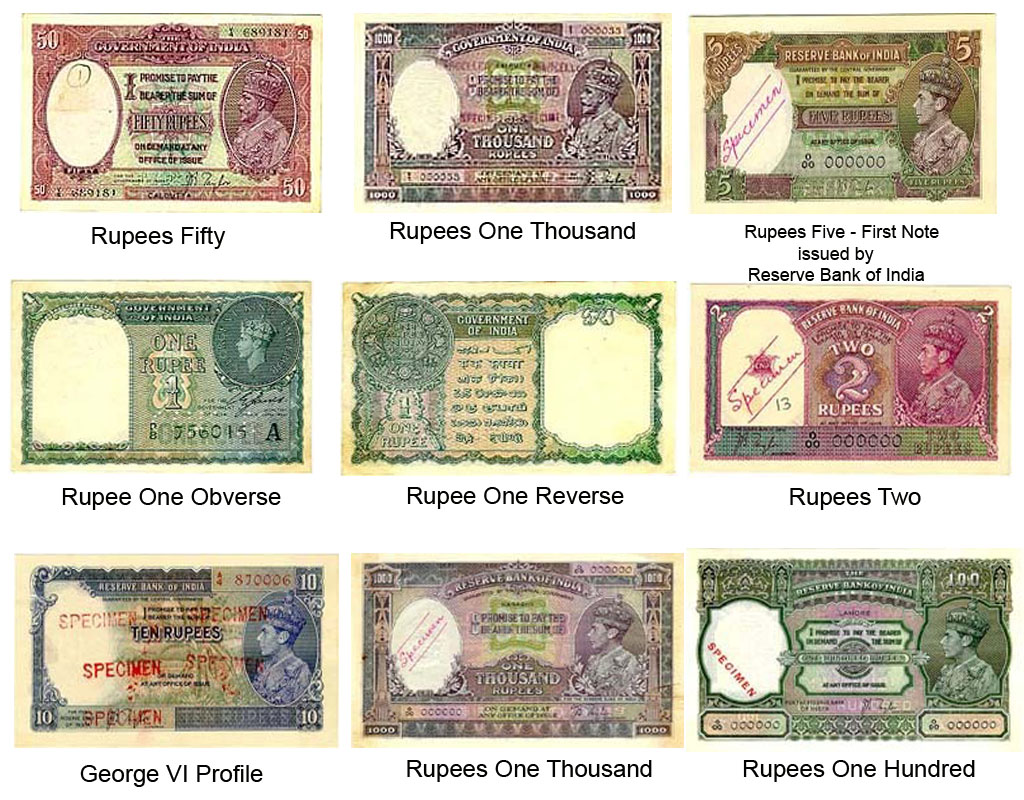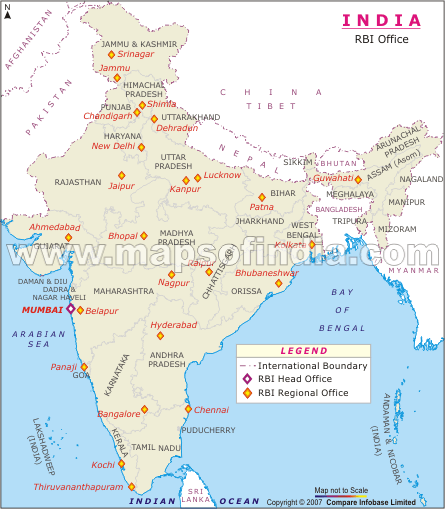KNOW YOUR CURRENCY

|
KNOW YOUR CURRENCY |
1.0 Introduction
1.1 Learning Objectives
1.2 History of Indian Coins and Currency
1.2.1 Denomination of banknotes and coins issued in India
1.2.2 Issuer of banknotes and coins
1.3 Importance of "Legal Tender"
1.3.1 Promissoiry Clause
1.4 Currency Management
1.4.1 Role of Reserve Bank of India
1.4.2 Role of Government of India
1.4.3 Decision regarding volume and value of banknotes to be printed
1.4.4 Circulation of banknotes and coins
1.4.5 Role of Currency Chests and Coin Depots
1.5 Soiled and Muitilated Bank Notes
1.5.1 Exchange of Soiled and Mutilated Notes
1.6 Counterfeit and Forged Notes
1.6.1 Security Features in banknotes
1.7 Clean Note Policy
1.8 Let us sum up
1.9. Glossary/Keywords
1.10 Refernce and Further readings
1.11 Answer to Self Assessment Questions

|
Introduction |
You know that money is defined as anything that is generally accepted as payment for goods and services and repayment of debts. The main uses of money for us are as a medium of exchange, a unit of account, and a store of value.
You may find that money as a means of payment consists of coins, paper money and withdrawable bank deposits by cheques and withdrawal slips. Today, you have credit cards, debit cards, electronic cash and mobile banking , which also form an important component of the payment system but for a common person like us , money simply means currency and coins. This is so because in India, the payment system, especially for retail transactions still revolves mainly around currency and coins.
We know that the Indian currency is called the Indian Rupee (INR) and the coins are called paise. One Rupee consists of 100 paise.
| 1.2 History of Indian Coins and Currency |
I. Coins
It would be interesting for us to know that the first documented coinage seems to have started with 'Punch Marked' coins issued between the 7th-6th Century BC and 1st Century AD. You can classsify the coin age into the following periods:
a. Ancient
b. Medival
c. Mughal
d. Late pre-colonial
e. British India
f. Republic India
g. Others
You can see some ancient coins below, which were in circulation in our provincial states. They were isuued by different states under various kings:
Now you see the modern day coins here, which of course have undergone changes over a period of time:
Our country won its independence on August 15, 1947. During the period of transition India retained the monetary system and the currency and coinage of the earlier period. India brought out its distinctive coins on 15th August, 1950.
Our coins are presently being issued in denominations of 25 paise, 50 paise, one rupee, two rupees and five rupees. Coins upto 50 paise are called 'small coins' and coins of Rupee one and above are called 'Rupee Coins'. Our coins can be issued up to the denomination of Rs.1000 as per the Coinage Act, 1906.
II. Currency
Our financial instruments and 'Hundies' in India have a venerable history. Our paper money, in the modern sense, traces its origins to the late eighteenth century with the issues of private banks as well as those of semi-government banks. The Paper Currency Act of 1861 conferred upon Government of India the monopoly of Note Issue bringing to end banknote issues of Private and Presidency Banks. Government of India continued to issue currency notes till the Reserve Bank of India (RBI) was established on 1st April, 1935. Reserve Bank issued banknotes in January 1938 when the first Five Rupee banknote was issued bearing the portrait of George VI.
This was followed by Rs. 10 in February, Rs. 100 in March and Rs. 1,000 and Rs. 10,000 in June 1938. The George VI series continued till 1947 and thereafter as a frozen series till 1950 when post independence banknotes were issued, with the Ashoka Pillar watermark.
Our banknotes in the Mahatma Gandhi Series were introduced in 1996 and were issued in a phased manner in the denominations of Rs.5, Rs.10, Rs.20, Rs.50,Rs.100, Rs.500 and Rs.1000.
You can have a look below at the modern day currency notes, which we use in our day to day transactions.
The following are some old Indian currency notes:
Below here you can see how our old British currency notes looked like!
The following are some other old British curreny notes:
.
| 1.2.1 Denomination of Notes and Coins issued in India |
At present, our banknotes in India are issued in the denomination of Rs.10, Rs.20, Rs.50, Rs.100, Rs.500 and Rs.1000. You call these notes as banknotes as they are issued by the Reserve Bank of India. Our printing of notes in the denominations of Re.1, Rs. 2 and Rs.5 has been discontinued as these denominations have been coinised. However, you can find such banknotes issued earlier in circulation and these banknotes continue to be legal tender for us.
The Reserve Bank can also issue banknotes in the denominations of five thousand rupees and ten thousand rupees, or any other denomination that the Central Government may specify. Though,you cannot have banknotes in denominations higher than ten thousand rupees in terms of the current provisions of the Reserve Bank of India of Act, 1934. Our coins can be issued up to the denomination of Rs.1000.
Demonetization of higher denomination banknotes
We find that Rs. 1000 and Rs.10000 banknotes, which were then in circulation were demonetized in January 1946, primarily to curb unaccounted money in our system. However, we reintroduced the higher denomination banknotes in Rs.1000, Rs.5000 and Rs.10000 in the year 1954, and these banknotes (Rs.1000, Rs.5000 and Rs.10000) were again demonetized in January 1978.
Present available denominations of coins in circulation in India
Presently we have 25 paise, 50 paise, one rupee, two rupees and five rupee coins being issued. Our coins up to 50 paise are called 'small coins' and coins of Rupee one and above are called 'Rupee Coins'. Though our coins in the denomination of 1 paise, 2 paise, 3 paise, 5 paise, 10 paise and 20 paise may still be in circulation, but due to lack of demand we have discontinued the issue of such coins.
.
| 1.2.2 Issuer of Notes and Coins |
In India our coins are minted by the Government of India mints while the notes are printed by the Reserve Bank of India (RBI) and Government of India presses. We have four mints in India located at Kolkata, NOIDA, Mumbai and Hyderabad. Regarding note printing presses RBI has its Bharatiya Reserve Bank Note Mudran Private Limited (BRBNMPL) presses at Salboni in West Bengal which is about 200 kms from Kolkata and another one at Mysore in Karnatka. you will find the government presses located at Dewas in Madhya Pradesh and Nasik in Maharashtra. You may understand that most of the high denomination notes are printed at RBI presses.
.
| 1.3 Importance of Legal Tender |
What is legal tender?
Our coins which are issued under the authority of Section 6 of the Coinage Act, 1906, shall be legal tender in payment or on account i.e. provided that a coin has not been defaced and has not lost weight so as to be less than such weight as may be prescribed in its case: -
(a) coin of any denomination not lower than one rupee shall be legal tender for any sum,
(b) half rupee coin shall be legal tender for any sum not exceeding ten rupees,
(c) any other coin shall be legal tender for any sum not exceeding one rupee [Section 13 of The Coinage Act, 1906].
Similarly, your One Rupee notes issued under the Currency Ordinance, 1940 are also legal tender and included in the expression Rupee coin for all the purposes of the Reserve Bank of India Act, 1934.
Your every banknote issued by Reserve Bank of India (Rs.2, Rs.5, Rs.10, Rs.20, Rs.50, Rs.100, Rs.500 and Rs.1000) shall be legal tender at any place in India in payment or on account for the amount expressed therein, and shall be guaranteed by the Central Government, subject to provisions of sub-section (2) Section 26 of RBI Act, 1934.
| 1.3.1 Promissory Clause |
You will find a Promissory Clause in all the banknotes. What exactly is this? This means that as per Section 26 of Reserve Bank of India Act, 1934, the Bank is liable to pay you the value of a banknote. This is payable to you on demand by RBI, being the issuer. The Bank's obligation to pay the value of banknote to you does not arise out of a contract but out of statutory provisions.
The promissory clause printed on the banknotes i.e., "I promise to pay the bearer an amount of X" is a statement which means that your banknote is a legal tender for X amount. The obligation on the part of the Bank is to exchange your banknote for coins of an equivalent amount.

|
Self-Assessment Questions (SAQs) -4 |
| 1. Write the meaning of Legal Tender in your own words?
2. Who is the promissory in banknote? 3. The guaranteer of a banknote is RBI.-(True/False) | |
.
| 1.4 Currency Management |
We find that the Department of Currency Management (DCM) in Reserve Bank of India has the responsibility of administering the functions of currency management, a core function of the Reserve Bank in terms of the Reserve Bank of India Act, 1934.
For us currency management essentially relates to issue of our notes and coins and retrieval of unfit notes from circulation. This work is performed through 18 issue offices of the Reserve Bank and a wide network of 4195 currency chests, 488 repositories and 3562 small coin depots managed by banks and Government treasuries.
| 1.4.1 Role of Reserve Bank of India |
The Reserve Bank derives its role in currency management from the Reserve Bank of India Act, 1934.The Reserve Bank manages currency in India for us. Our Government, on the advice of the Reserve Bank, decides on various denominations of banknotes to be issued for us. The Reserve Bank also co-ordinates with the Government in the designing of of our banknotes, including the security features. The Reserve Bank estimates the quantity of banknotes that are likely to be needed denomination-wise and accordingly, places indent with the various printing presses. We find that the banknotes which are received from banks and currency chests are examined and those fit for circulation are reissued and the others (soiled and mutilated) are destroyed so as to maintain the quality of banknotes in circulation.
As you already know Reserve Bank of India was established on April 1, 1935 in accordance with the provisions of the Reserve Bank of India Act, 1934.
The Central Office of the Reserve Bank of India was initially established in Calcutta (now Kolkata) but was later shifted to Mumbai (then Bombay) in 1937. The Central Office is where the Governor sits and where policies are formulated. Though, originally privately owned, since nationalization in 1949, the Reserve Bank is fully owned by the Government of India.
The Preamble of the Reserve Bank of India describes the basic activities of the Reserve Bank as:
"...to regulate the issue of Bank Notes and keeping of reserves with a view to securing monetary stability in India and generally to operate the currency and credit system of the country to its advantage."
The follwing map shows the location of RBI offices:
| 1.4.2 Role of Government of India |
In terms of Section 25 of RBI Act, 1934 the design of our banknotes is required to be approved by the Central Government on the recommendations of the Central Board of the Reserve Bank of India. The responsibility for our coinage vests with the Government of India on the basis of the Coinage Act, 1906 as amended from time to time. The Government of India also attends to the designing and minting of our coins in various denominations.
.
| 1.4.3 Decision regarding volume and value of banknotes to be printed |
The Reserve Bank decides the volume and value of banknotes to be printed for us each year. The quantum of banknotes that needs to be printed, broadly depends on our requirement for meeting the demand for banknotes due to inflation, GDP growth, replacement of soiled banknotes and reserve stock requirements. The Government of India decides the quantity of our coins to be minted on the basis of indents received from the Reserve Bank.
The Reserve Bank estimates the demand for banknotes on the basis of our growth rate of the economy, our replacement demand and our reserve stock requirements by using statistical models/techniques.
| 1.4.4 Circulation of banknotes and coins |
The Reserve Bank presently manages our currency operations through its 18 Issue offices located at Ahmedabad, Bangalore, Belapur, Bhopal, Bhubaneswar, Chandigarh, Chennai, Guwahati, Hyderabad, Jaipur, Jammu, Kanpur, Kolkata, Mumbai, Nagpur, New Delhi, Patna, Thiruvananthapuram, one sub-office at Lucknow, a currency chest at Kochi and a wide net work of currency chests. These offices receive fresh banknotes from the banknote printing presses. We understand that the Issue Offices of RBI send fresh banknote remittances to the designated branches of commercial banks.
The Reserve Bank offices located at Hyderabad, Kolkata, Mumbai and New Delhi (Mint linked Offices) initially receive the coins from the mints. These offices then send them to the other offices of the Reserve Bank. The banknotes and rupee coins are stocked at the currency chests and small coins at the Small Coin Depots(SCD). The bank branches receive the banknotes and coins from the Currency Chests and Small Coin Depots for further distribution among the public.
Our banknotes and coins returned from circulation are deposited at the Issue offices of the Reserve Bank. The Reserve Bank subjects these to processing, authenticates banknotes for their genuineness, segregates them into notes fit for reissue and those which are not, for cancellation. Our banknotes which are fit for reissue are sent back in circulation and those which are unfit for reissue are destroyed by way of shredding after completion of examination process. Similarly, some of our coins received back from circulation are either reissued or are sent to the Mints for melting.

|
Self-Assessment Questions (SAQs) -6 |
| 1. Which are the Mint Linked offices of RBI?
2. What happens to notes which are not fit for circulation? 3. SCD stands for ______________. | |
.
| 1.4.5 Role of Currency Chests and Coin Depots |
To facilitate the distribution of our banknotes and rupee coins, the Reserve Bank has authorised select branches of scheduled banks to establish Currency Chests. You find that hese are actually storehouses where banknotes and rupee coins are stocked on behalf of the Reserve Bank. As on June 30, 2008, we have 4271 Currency Chests and 4033 Small Coin Depots. The currency chest branches are expected to distribute banknotes and rupee coins to our other bank branches in their area of operation.
We find that some bank branches are also authorised to establish Small Coin Depots to stock small coins. Our Small Coin Depots also distribute small coins to other bank branches in their area of operation.
| 1.5 Soiled and Mutilated Banknotes |
Soiled banknotes are your banknotes, which have become dirty and limp due to excessive use. You see from the follwing images how our solied notes look like.
Mutilated banknotes are your banknotes, which are torn, disfigured, burnt, washed, eaten by white ants, etc. Your double numbered banknote cut into two pieces but on which both the numbers are intact is now being treated as soiled banknote. You can have a look at some mutilated notes below.
All our banks are authorised to accept our soiled banknotes across their counters and pay us the exchange value. They are expected to offer this service even to non-customers. All our designated branches of commercial banks are authorised to adjudicate and pay us the value in respect of mutilated banknotes, in terms of the Reserve Bank of India (Note Refund) Rules, 1975. The RBI has also authorised all our commercial bank branches to treat certain banknotes in ‘two pieces’ as soiled banknotes and pay the exchange value to us.
| 1.5.1 Exchange of Soiled and Mutilated Banknotes |
All bank branches have been authorised to provide you the facility of exchanging soiled banknotes. Soiled banknotes can be exchanged by you for full value. Your payment of value of mutilated banknotes is governed by the Reserve Bank of India (Note Refund) Rules, 1975. These Rules have been framed under Section 28 of the Reserve Bank of India Act, 1934. You can get value for these banknotes as a matter of grace as laid down in the Rules, after adjudication. Currently, the Reserve Bank and other authorised banks have provisions for paying you either full, half or no value as far as the banknotes in the denomination for Rs.10 and above are concerned; as regards Re.1, Rs.2 & Rs.5, you can get either full or no value depending upon the condition of the banknote.
The following banknotes are not payable to you under the Reserve Bank of India (Note Refund) Rules 1975.
A banknote, which is
- less than half the area of the full banknote
- devoid of the major portion of the number on an undivided area, i.e., the prefix and three digits or four digits of the number in banknotes up to and inclusive of Rs.5; in respect of banknotes of Rs.10 and above,
- where this inadequacy is present at both the numbering panels.
- cancelled by any office of the Reserve Bank or against which the value has already been paid
- found to be forged / counterfeit
- deliberately cut, mutilated or tampered carrying extrinsic words or visible representation intended to convey or capable of conveying any message of a political character
.
| 1.6 Counterfeit and Forged Notes |
Our banknote on which the security features of genuine banknotes are not available / absent can be suspected to be a counterfeit banknotes and examined minutely. Counterfeiting banknotes / using as genuine, forged or counterfeit banknotes / possession of forged or counterfeit banknote / making or possessing instruments or materials for forging or counterfeiting banknotes making or using documents resembling banknotes are offences under Sections 489A to 489E of our Indian Penal Code and are punishable in the Courts of Law by fine or imprisonment ranging from seven years to life imprisonment or both, depending on the offence.

|
Self-Assessment Questions (SAQs) -8 |
| 1.Is possession of a forged banknote an offence?
2.Offences regarding counterfeiting of banknotes are dealt under________________. | |
.
| 1.6.1 Secuirity Features in Banknotes |
Secuirity features are incorportated in the banknotes to help us to ascertain genuineness and to discourage forgery. RBI has introduced new security features for the benefit of the public.
Our Mahatma Gandhi series-1996 banknotes contained several special features vis-à-vis the banknotes issued earlier. These are
i. Security thread: Our Rs.10, Rs.20 and Rs.50 notes contain fully embedded security thread. Rs.100, Rs.500 and Rs.1000 banknotes contain windowed security thread. You can see this thread as partially exposed and partially embedded. When you hold it against light, you can see this thread as one continuous line. Other than on Rs.1000 banknotes, you can see that this thread contains the words 'Bharat' in the Devanagari script and 'RBI' appearing alternately. The security thread of our Rs.1000 banknote contains the inscription 'Bharat' in the Devanagari script, '1000' and 'RBI'.
ii. Latent Image: The vertical band next to the (right side) Mahatma Gandhi’s portrait, contains a latent image, showing us the denominational value 20, 50, 100, 500 or 1000 as the case may be. We can see the value only when the banknote is held horizontally and light allowed to fall on it at 45° ; otherwise this feature appears only as a vertical band.
iii. Micro letterings: This feature appears between the vertical band and Mahatma Gandhi portrait. You will find that it contains the word ‘RBI’ in Rs.10. Our notes of Rs.20 and above also contain the denominational value of the banknotes. This feature can be seen by us better under a magnifying glass.
iv. Identification mark: A special intaglio feature (raised printing) has been introduced on the left of the watermark window, on the obverse (front) on all banknotes except Rs.10/- banknote. This feature is in different shapes for various denominations (Rs.20-Vertical Rectangle, Rs.50-Square, Rs.100-Triangle, Rs.500-Circle, Rs.1000-Diamond) and helps the visually impaired to identify the denomination
v. Intaglio Printing: You will find that the portrait of Mahatma Gandhi, Reserve Bank seal, Guarantee and promise clause, Ashoka Pillar Emblem and RBI Governor's signature are printed in intaglio i.e. in raised prints in Rs.20, Rs.50, Rs.100, Rs.500 and Rs.1000 banknotes.
vi. Fluorescence: The number panels of the banknotes are printed in fluorescent ink. Our banknotes also have optical fibres. You can see both when the banknotes are exposed to ultra-violet lamp.
vii. Optically Variable Ink: The numeral 500 & 1000 on the Rs.500 [revised colour scheme of mild yellow, mauve and brown] and Rs.1000 banknotes are printed in Optically Variable Ink viz., a colour-shifting ink. You can see that the colour of these numerals appears green when the banknotes are held flat but you would find them change to blue when the banknotes are held at an angle.
viii. Watermark: Our banknotes also contain the Mahatma Gandhi watermark with a light and shade effect and multi-directional lines in the watermark window.
The additional / new security features in MG Series 2005 banknotes.
i. Security Thread: The machine-readable security thread in Rs.10, Rs.20 and Rs.50 denomination banknotes is windowed on front side and fully embedded on reverse side.You will find that the thread fluoresces in yellow on both sides under ultraviolet light. The thread appears as a continuous line from behind when you hold up against light.
ii. Our Rs.100, Rs.500 and Rs.1000 denomination banknotes have machine-readable windowed security thread with colour shift from green to blue when you view from different angles. You can see that it fluoresces in yellow on the reverse and the text will fluoresce on the obverse under ultraviolet light.
iii. Intaglio Printing: In this we find that the portrait of Mahatma Gandhi, Reserve Bank seal, Guarantee and promise clause, Ashoka Pillar emblem, Governor's signature and the identification mark for the visually impaired persons are printed in improved intaglio.
iv. See through register: Half the numeral of each denomination (10, 20, 50, 100, 500 and 1000) is printed on the obverse (front) and half on the reverse. The accurate back to back registration makes the numeral appear as one when viewed against light.
v. Water Mark and electrotype watermark: The portrait of Mahatma Gandhi, the multi-directional lines and an electrotype mark showing the denominational numeral 10, 20, 50, 100, 500 and 1000 appear in this section respectively in each denomination banknote and these can be viewed better when you banknote is held against light.
vi. Optically Variable Ink (OVI): The font size of the numeral 500 and 1000 in Rs.500 and Rs.1000 denomination banknotes is reduced, as compared to MG series banknotes issued in these denominations earlier in the year 2000. You will see that the colour of the numeral appears green when the banknote is held flat but it would change to blue when you hold the banknote at an angle.
vii. Dual coloured optical fibres, You can see under UV lamp.
viii. Year of Printing: You can see the year of printing on the reverse of the banknote
Inorder to see the above security features in detail you can also click on the RBI link alongside to see them more elaborately.[1]

|
Self-Assessment Questions (SAQs) -9 |
| 1. What is intaglio printing?
2. Can blind people recognise Indian currency notes? Explain. 3. Write five secuirity features of your Rs.100 bankote. | |
.
| 1.7 Clean Note Policy |
Now you can appreciate that Reserve Bank of India has been continuously making efforts to make good quality banknotes available to the members of public. To help RBI and banking system, you and the members of public are requested to ensure the following:
- You shold not staple the banknotes
- You should desist from writing/putting rubber stamp or any other mark on the banknotes
- You should store your banknotes safely to prevent any damage
These practices would lead more life to our currency and improve the image of our banknotes in the eyes of the public. You should teach and practice these habits in your own house , in public and at your place.

|
Self-Assessment Questions (SAQs) -10 |
| 1. What do you understand by a clean note?
2. How are you going to convince your neighbour regarding Clean Note Policy of RBI? | |
.

|
Results |

|
Glossary |
1. Act- Any legislation passed by Parliament.
2. Banking- A company authorised by RBI to take deposits from the public for the purpose of lending and investment and repayable on demand by way of cheque , draft or cash.
3. Banknote –Currency issued by the Reserve Bank of India.
4.Clean Note -Banknotes which are not to stapled, nothing is written / no rubber stamp or any other mark on the banknotes .
5. Counterfeit banknotes-Banknote on which the security features of genuine banknotes are not available / absent.
6. Currency Chest- Branches stoking currency notes on behalf of RBI. It is an extension of RBI vault.
7. Intaglio Printing-Raised printing in banknotes.
8. Optically Variable Ink (OVI)-The colour of the numeral appears green when the banknote is held flat but would change to blue when the banknote is held at an angle.
9. Mutilated banknotes- Banknotes, which are torn, disfigured, burnt, washed, eaten by white ants, etc.
10. Soiled banknotes- Banknotes, which have become dirty and limp due to excessive use. A double numbered banknote cut into two pieces but on which both the numbers are intact is now being treated as soiled banknote

|
Practice Test |
I hope after going throgh this lesson you are in a position to answer the following questions in your own words.
1. What is the Indian currency called?
2. What are the present denominations of banknotes you can find in India?
3. What are the present available denominations of coins in India?
4. What do you understand by a "legal tender"?
5. What is the meaning of "I promise to pay" clause?
6. What is the role of the Reserve Bank of India in currency management?
7. Who decides on the volume and value of banknotes to be printed and on what basis?
8. Who decides on the quantity of coins to be minted?
9. How does the Reserve Bank estimate the demand for banknotes?
10. What is a currency chest?
11. What is a small coin depot?
12. What happens when the banknotes and coins return from circulation?
13. From where can you obtain banknotes and coins?
14. What are soiled and mutilated banknotes? Can such banknotes be exchanged for value?
15. What types of banknotes are not eligible for payment under the Note Refund Rules?
16. How do you differentiate between a genuine banknote and forged / counterfeit banknote.

|
Answers to SAQs |
The following are the answers to the SAQs in this lesson
SAQ-1
1. Rupees Five
2. 1996
3. Hundies are financial instruments .
SAQ-2
1. Rs.10,000/-
2. Rs.1000/-
3. 1978
4. Coins of Rupee one and above are called 'Rupee Coins'.
SAQ-3
1. Banknotes and Coins
2. Bharatiya Reserve Bank Note Mudran Pvt. Limited (BRBNMPL)
3. (i) Kolkata (ii) NOIDA (UP) (iii) Hyderabad and (iv) Mumbai
SAQ-4
1. Legal Tender means the value shall be payed by the issuing authority.
2. The Governor of Reserve Bank of India.
3. False- It is the Central Government.
SAQ-5
1. Department of Currency Management
2. False- The Central Government.
3. The Reserve Bank of India.
SAQ-6
1. Hyderabad, Kolkata, Mumbai and New Delhi .
2. They are shredded for destruction.
3. SCD stands for Small Coin Depot.
SAQ-7
1. Soiled banknotes are banknotes, which have become dirty and limp due to excessive use.A double numbered banknote cut into two pieces but on which both the numbers are intact is now being treated as soiled banknote.
Mutilated banknotes are banknotes, which are torn, disfigured, burnt, washed, eaten by white ants, etc.
2. The Reserve Bank of India (Note Refund) Rules 1975
3. Soiled and Mutilated banknotes.
4. No. It is only as of grace.
SAQ-8
1.Yes it is an offence?
2.Under Sections 489A to 489E of the Indian Penal Code and are punishable in the Courts of Law by fine or imprisonment ranging from seven years to life imprisonment or both, depending on the offence.
SAQ-9
1. It is raised printing of certain features on a banknote like denomination, signature of the promissor etc.
2. Yes by way of touching the intaglio printing on different denomination of banknotes near the watermark which are in the form a square, triangle etc.
3. The following are the five security features in a banknote of Rs.100/-
(a) Security Thread: The machine-readable security thread in Rs.10, Rs.20 and Rs.50 denomination banknotes is windowed on front side and fully embedded on reverse side. The thread fluoresces in yellow on both sides under ultraviolet light. The thread appears as a continuous line from behind when held up against light.Rs.100, Rs.500 and Rs.1000 denomination banknotes have machine-readable windowed security thread with colour shift from green to blue when viewed from different angles. It fluoresces in yellow on the reverse and the text will fluoresce on the obverse under ultraviolet light.
(b) Intaglio Printing: The portrait of Mahatma Gandhi, Reserve Bank seal, Guarantee and promise clause, Ashoka Pillar emblem, Governor's signature and the identification mark for the visually impaired persons are printed in improved intaglio.
(c) See through register: Half the numeral of each denomination (10, 20, 50, 100, 500 and 1000) is printed on the obverse (front) and half on the reverse. The accurate back to back registration makes the numeral appear as one when viewed against light.
(d) Water Mark and electrotype watermark: The portrait of Mahatma Gandhi, the multi-directional lines and an electrotype mark showing the denominational numeral 10, 20, 50, 100, 500 and 1000 appear in this section respectively in each denomination banknote and these can be viewed better when the banknote is held against light.
(e) Optically Variable Ink (OVI):The font size of the numeral 500 and 1000 in Rs.500 and Rs.1000 denomination banknotes is reduced, as compared to MG series banknotes issued in these denominations earlier in the year 2000. The colour of the numeral appears green when the banknote is held flat but would change to blue when the banknote is held at an angle.
SAQ-10
1. Banknotes which are not to stapled and on which nothing is written or do not bear any rubber stamp or any other mark on them are called as clean notes.
2. Reserve Bank of India has been continuously making efforts to make good quality banknotes available to the members of public. To help RBI and banking system, I shall convince my neighbour not to staple , not to write, not to handle his banknotes carelessly . He should also store the banknotes safely to prevent any damage.

|
References and Further Readings |
1. History of Reserve Bank of India Vol-I
2. The Reserve Bank of India Act 1934
3. The Coinage Act 1906
4. The Paper Currency Act of 1861
5. The Reserve Bank of India (Note Refund) Rules, 1975
6. The Currency Ordinance, 1940
7. The Reserve Bank of India website [2]



